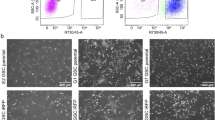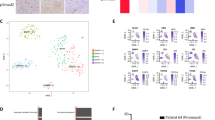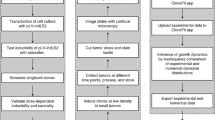Abstract
Bioluminescence imaging has previously been used to monitor the formation of grafted tumors in vivo and measure cell number during tumor progression and response to therapy. The development and optimization of successful cancer therapy strategies may well require detailed and specific assessment of biological processes in response to mechanistic intervention. Here, we use bioluminescence imaging to monitor the cell cycle in a genetically engineered, histologically accurate model of glioma in vivo. In these platelet-derived growth factor (PDGF)-driven oligodendrogliomas, G1 cell-cycle arrest is generated by blockade of either the PDGF receptor or mTOR using small-molecule inhibitors.
This is a preview of subscription content, access via your institution
Access options
Subscribe to this journal
Receive 12 print issues and online access
$209.00 per year
only $17.42 per issue
Buy this article
- Purchase on Springer Link
- Instant access to full article PDF
Prices may be subject to local taxes which are calculated during checkout



Similar content being viewed by others
References
Sherr, C.J. & McCormick, F. The RB and p53 pathways in cancer. Cancer Cell 2, 103–112 (2002).
Johnson, D.G., Ohtani, K. & Nevins, J.R. Autoregulatory control of E2F1 expression in response to positive and negative regulators of cell cycle progression. Genes Dev. 8, 1514–1525 (1994).
Parr, M.J. et al. Tumor-selective transgene expression in vivo mediated by an E2F- responsive adenoviral vector. Nat. Med. 3, 1145–1149 (1997).
Contag, C.H. et al. Visualizing gene expression in living mammals using a bioluminescent reporter. Photochem. Photobiol. 66, 523–531 (1997).
Gelovani Tjuvajev, J. & Blasberg, R.G. In vivo imaging of molecular-genetic targets for cancer therapy. Cancer Cell 3, 327–332 (2003).
Massoud, T.F. & Gambhir, S.S. Molecular imaging in living subjects: seeing fundamental biological processes in a new light. Genes Dev. 17, 545–580 (2003).
Choy, G. et al. Comparison of noninvasive fluorescent and bioluminescent small animal optical imaging. Biotechniques 35, 1022–1030 (2003).
Contag, P.R., Olomu, I.N., Stevenson, D.K. & Contag, C.H. Bioluminescent indicators in living mammals. Nat. Med. 4, 245–247 (1998).
Holland, E.C. Gliomagenesis: genetic alterations and mouse models. Nat. Rev. Genet. 2, 120–129 (2001).
Dai, C. et al. PDGF autocrine stimulation dedifferentiates cultured astrocytes and induces oligodendrogliomas and oligoastrocytomas from neural progenitors and astrocytes in vivo. Genes Dev. 15, 1913–1925 (2001).
Shih, A. et al. Dose dependent effects of PDGF-B on glial tumorigenesis. Cancer Res. (in press).
Podsypanina, K. et al. An inhibitor of mTOR reduces neoplasia and normalizes p70/S6 kinase activity in Pten+/− mice. Proc. Natl. Acad. Sci. USA 98, 10320–10325 (2001).
Burgos, J.S. et al. Time course of bioluminescent signal in orthotopic and heterotopic brain tumors in nude mice. Biotechniques 34, 1184–1188 (2003).
Rehemtulla, A. et al. Rapid and quantitative assessment of cancer treatment response using in vivo bioluminescence imaging. Neoplasia 2, 491–495 (2000).
Rehemtulla, A. et al. Molecular imaging of gene expression and efficacy following adenoviral-mediated brain tumor gene therapy. Mol. Imaging 1, 43–55 (2002).
Shah, K., Tang, Y., Breakefield, X. & Weissleder, R. Real-time imaging of TRAIL-induced apoptosis of glioma tumors in vivo. Oncogene 22, 6865–6872 (2003).
Dai, C. et al. The characteristics of astrocytomas and oligodendrogliomas are caused by two distinct interchangable signaling formats. Neoplasia (in the press).
Garami, A. et al. Insulin activation of Rheb, a mediator of mTOR/S6K/4E-BP signaling, is inhibited by TSC1 and 2. Mol. Cell 11, 1457–1466 (2003).
Rajasekhar, V.K. et al. Oncogenic Ras and Akt signaling contribute to glioblastoma formation by differential recruitment of existing mRNAs to polysomes. Mol. Cell 12, 889–901 (2003).
Acknowledgements
The authors would like to thank C. Glaster for preparation of this manuscript, C. Discafani (Wyeth Research) for the CCI-779 and J. Wood (Novartis Pharmaceuticals) for the PTK787/ZK222584. This work was supported by the Tow, Seroussi, Bressler and Kirby Foundations.
Author information
Authors and Affiliations
Corresponding author
Ethics declarations
Competing interests
The authors declare no competing financial interests.
Supplementary information
Supplementary Fig. 1
The Efluc transgene structure and strategy for its use. (PDF 22 kb)
Supplementary Fig. 2
Luciferase activity in vivo after luciferin injection. (PDF 68 kb)
Rights and permissions
About this article
Cite this article
Uhrbom, L., Nerio, E. & Holland, E. Dissecting tumor maintenance requirements using bioluminescence imaging of cell proliferation in a mouse glioma model. Nat Med 10, 1257–1260 (2004). https://doi.org/10.1038/nm1120
Received:
Accepted:
Published:
Issue Date:
DOI: https://doi.org/10.1038/nm1120
This article is cited by
-
Development of two mouse strains conditionally expressing bright luciferases with distinct emission spectra as new tools for in vivo imaging
Lab Animal (2023)
-
Glucuronidation of d-Luciferin In Vitro: Isoform Selectivity and Kinetics Characterization
European Journal of Drug Metabolism and Pharmacokinetics (2019)
-
Cross-species transcriptional analysis reveals conserved and host-specific neoplastic processes in mammalian glioma
Scientific Reports (2018)
-
Inhibition of colony stimulating factor-1 receptor abrogates microenvironment-mediated therapeutic resistance in gliomas
Oncogene (2017)
-
Antioxidative effects in vivo and colonization of Lactobacillus plantarum MA2 in the murine intestinal tract
Applied Microbiology and Biotechnology (2016)



